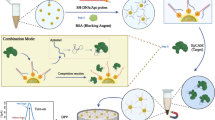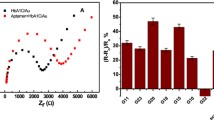Abstract
Presently, most reported electrochemical biosensors, for highly sensitive and selective detection of nucleic acid, still require multiple, time-consuming assembly steps and high-consumption DNA probes as well as lack good performance in human serum, which greatly limit their applicability. Herein, an easy-to-fabricate electrochemical DNA biosensor constructed by assembly of bovine serum albumin (BSA) followed with direct incubation of amplified products has been proposed. This method combined terminal deoxynucleoside transferase (TdTase)–mediated isothermal amplification and polyHRP catalysis to achieve dual-signal enhancement, and was featured with low-density DNA monolayer for its employment of only 2 nM capture probes. Surprisingly, based on the low-density DNA monolayer, the steric hindrance effect of polyHRP could effectively restrain the background compared with HRP, which further pushes the signal-to-noise (S/N) ratio to 70 than that of most currently available methods. Additionally, this strategy also showed favorable specificity and powerful anti-interference in human serum, and thus potentially attractive for diagnosis of diseases.








Similar content being viewed by others
References
Zhang HL, Liu XH, Liu MH, Gao T, Huang YZ, Liu Y, et al. Gene detection: an essential process to precision medicine. Biosens Bioelectron. 2018;99:625–36.
Choi JR, Hu J, Tang RH, Gong Y, Feng SS, Ren H, et al. An integrated paper-based sample-to-answer biosensor for nucleic acid testing at the point of care. Lab Chip. 2016;16:611–21.
Wang YQ, Qu JX, Ba Q, Dong JH, Zhang L, Zhang H, et al. Detection and typing of human-infecting influenza viruses in China by using a multiplex DNA biochip assay. J Virol Methods. 2016;234:178–85.
Dong J, Chen GY, Wang W, Huang X, Peng HP, Pu QL, et al. Colorimetric PCR-based microRNA detection method based on small organic dye and single enzyme. Anal Chem. 2018;90:7107–11.
Jae-Ho K, Jeong-Eun P, Mouhong L, Sungi K, Gyeong-Hwan K, SungJun P, et al. Sensitive, quantitative naked-eye biodetection with polyhedral Cu nanoshells. Adv Mater. 2017;29:1702945.
Ma Q, Gao ZQ. A simple and ultrasensitive fluorescence assay for single-nucleotide polymorphism. Anal Bioanal Chem. 2018;410:3093–100.
Nano A, Boynton AN, Barton JK. A rhodium-cyanine fluorescent probe: detection and signaling of mismatches in DNA. J Am Chem Soc. 2017;139:17301–4.
Park S, Jeong J-E, Le VS, Seo J, Yu B, Kim D-Y, et al. Enhanced electron transfer mediated by conjugated polyelectrolyte and its application to washing-free DNA detection. J Am Chem Soc. 2018;140:2409–12.
Wang S, Zhang LQ, Wan S, Cansiz S, Cui C, Liu Y, et al. Aptasensor with expanded nucleotide using DNA nanotetrahedra for electrochemical detection of cancerous exosomes. ACS Nano. 2017;11:3943–9.
Hou T, Liu XJ, Wang XZ, Jiang AW, Liu SF, Li F. DNAzyme-guided polymerization of aniline for ultrasensitive electrochemical detection of nucleic acid with bio-bar codes-initiated rolling circle amplification. Sensors Actuators B Chem. 2014;190:384–8.
Chen AY, Ma SY, Zhuo Y, Chai YQ, Yuan R. In situ electrochemical generation of electrochemiluminescent silver naonoclusters on target-cycling synchronized rolling circle amplification platform for microRNA detection. Anal Chem. 2016;88:3203–10.
Xie SB, Yuan YL, Chai YQ, Yuan R. Tracing phosphate ions generated during loop-mediated isothermal amplification for electrochemical detection of nosema bombycis genomic DNA PTP1. Anal Chem. 2015;87:10268–74.
Hsieh K, Patterson AS, Scott FB, Plaxco KW, Soh HT. Rapid, sensitive, and quantitative detection of pathogenic DNA at the point of care through microfluidic electrochemical quantitative loop-mediated isothermal amplification. Angew Chem Int Ed. 2012;51:4896–900.
Del Río JS, Svobodova M, Bustos P, Conejeros P, O'Sullivan CK. Electrochemical detection of Piscirickettsia salmonis genomic DNA from salmon samples using solid-phase recombinase polymerase amplification. Anal Bioanal Chem. 2016;408:8611–20.
Fang CS, Kim K-S, Ha DT, Kim M-S, Yang H. Washing-free electrochemical detection of amplified double-stranded DNAs using a zinc finger protein. Anal Chem. 2018;90:4776–82.
Yu YY, Chen ZG, Jian WS, Sun DP, Zhang BB, Li XC, et al. Ultrasensitive electrochemical detection of avian influenza A (H7N9) virus DNA based on isothermal exponential amplification coupled with hybridization chain reaction of DNAzyme nanowires. Biosens Bioelectron. 2015;64:566–71.
Wang D, Chai YQ, Yuan YL, Yuan R. A peptide cleavage-based ultrasensitive electrochemical biosensor with an ingenious two-stage DNA template for highly efficient DNA exponential amplification. Anal Chem. 2017;89:8951–6.
Chow DC, Lee W-K, Zauscher S, Chilkoti A. Enzymatic fabrication of DNA nanostructures: extension of a self-assembled oligonucleotide monolayer on gold arrays. J Am Chem Soc. 2005;127:14122–3.
Yang F, Yang X, Wang YZ, Qin Y, Liu X, Yan XQ, et al. Template-independent, in situ grown DNA nanotail enabling label-free femtomolar chronocoulometric detection of nucleic acids. Anal Chem. 2014;86:11905–12.
Chen JY, Liu ZJ, Peng HP, Zheng YJ, Lin Z, Liu AL, et al. Electrochemical DNA biosensor based on grafting-to mode of terminal deoxynucleoside transferase-mediated extension. Biosens Bioelectron. 2017;98:345–9.
Liu YH, Li HN, Chen W, Liu AL, Lin XH, Chen YZ. Bovine serum albumin-based probe carrier platform for electrochemical DNA biosensing. Anal Chem. 2013;85:273–7.
Wan Y, Xu H, Su Y, Zhu XH, Song SP, Fan CH. A surface-initiated enzymatic polymerization strategy for electrochemical DNA sensors. Biosens Bioelectron. 2013;41:526–31.
Ge ZL, Lin MH, Wang P, Pei H, Yan J, Shi JY, et al. Hybridization chain reaction amplification of microRNA detection with a tetrahedral DNA nanostructure-based electrochemical biosensor. Anal Chem. 2014;86:2124–30.
Wan Y, Wang PJ, Su Y, Wang LH, Pan D, Aldalbahi A, et al. Nanoprobe-initiated enzymatic polymerization for highly sensitive electrochemical DNA detection. ACS Appl Mat Interfaces. 2015;7:25618–23.
Li C, Wu D, Hu XL, Xiang Y, Shu YQ, Li GX. One-step modification of electrode surface for ultrasensitive and highly selective detection of nucleic acids with practical applications. Anal Chem. 2016;88:7583–90.
Song P, Li M, Shen JW, Pei H, Chao J, Su S, et al. Dynamic modulation of DNA hybridization using allosteric DNA tetrahedral nanostructures. Anal Chem. 2016;88:8043–9.
Li LY, Wang LL, Xu Q, Xu L, Liang W, Li Y, et al. Bacterial analysis using an electrochemical DNA biosensor with poly-adenine-mediated DNA self-assembly. ACS Appl Mat Interfaces. 2018;10:6895–903.
Wu J, Campuzano S, Halford C, Haake DA, Wang J. Ternary surface monolayers for ultrasensitive (zeptomole) amperometric detection of nucleic acid hybridization without signal amplification. Anal Chem. 2010;82:8830–7.
Campuzano S, Kuralay F, Lobo-Castañón MJ, Bartošík M, Vyavahare K, Paleček E, et al. Ternary monolayers as DNA recognition interfaces for direct and sensitive electrochemical detection in untreated clinical samples. Biosens Bioelectron. 2011;26:3577–83.
Funding
This work was financially supported by the National Natural Science Foundation of China (21775023); the Medical Elite Cultivation Program of Fujian Province (2018-ZQN-49); the Open Program for the Key Lab/Research Platform of the First Affiliated Hospital of Fujian Medical University (FYKFKT-201707); the Outstanding Youth Scientific Research Personnel Training Plan of Colleges and Universities in Fujian Province (2015B027); Joint Funds for the Innovation of Science and Technology in Fujian Province (2016Y9019); and the Special Fund of Youth Top-Notch Innovative Talents of Fujian Province (SQNBJ201601).
Author information
Authors and Affiliations
Corresponding authors
Ethics declarations
Conflict of interest
The authors declare that they have no competing interests.
Ethical standards and informed consent
This study conformed to the ethical guidelines of the Declaration of Helsinki and was approved by The Ethics Committee for Human Research, The First Affiliated Hospital of Fujian Medical University. Human serum samples used in this study do not have any identifying information about all the participants that provided written informed consent.
Additional information
Publisher’s note
Springer Nature remains neutral with regard to jurisdictional claims in published maps and institutional affiliations.
Electronic supplementary material
ESM 1
(PDF 388 kb)
Rights and permissions
About this article
Cite this article
Chen, J., Ye, C., Liu, Z. et al. Facilely prepared low-density DNA monolayer–based electrochemical biosensor with high detection performance in human serum. Anal Bioanal Chem 411, 2101–2109 (2019). https://doi.org/10.1007/s00216-019-01637-0
Received:
Revised:
Accepted:
Published:
Issue Date:
DOI: https://doi.org/10.1007/s00216-019-01637-0




